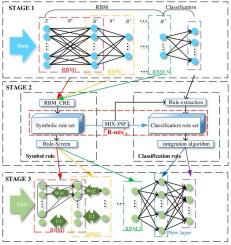Computers in Industry ( IF 8.2 ) Pub Date : 2020-06-17 , DOI: 10.1016/j.compind.2020.103262 Jianbo Yu , Guoliang Liu

|
The surface roughness prediction and knowledge discovery in the machining process are very important to optimize those process variables (e.g., spin speed, feed rate) online and then obtain high machining quality of products. Deep neural networks (DNNs) consist of a complex structure and multiple nonlinear processing units to perform deep feature learning. It has achieved great success in computer vision, natural language processing, and speech recognition. It is very appropriate to apply DNNs for modeling complex non-linear relationship between the process variables (e.g., spin speed, vibration) and the surface roughness. Due to the “black box” and the huge data demand problem, there are still huge obstacles to the applications of DNNs in real-world cases. This paper proposes a new DNN model, knowledge-based deep belief network (KBDBN), which integrates the symbol rules and classification rules with the deep network. This not only enables the model to have good feature learning performance, but also can discover the knowledge (i.e., rules) from the deep network. A KBDBN-based prediction model for workpiece surface roughness prediction is further proposed, which not only effectively discovery the knowledge (i.e., symbolic rules and classification rules) for process control, but also shows better recognition performance than that of the typical machine learning models (e.g., support vector machine, artificial neural network, logistic regression) and DNNs (e.g., deep belief network, stacked auto-encoder). Moreover, the interpretable DNN model makes it be applied easily in real-world cases.
中文翻译:

基于知识的深度置信网络,用于加工粗糙度预测和知识发现
加工过程中的表面粗糙度预测和知识发现对于在线优化那些工艺变量(例如旋转速度,进给速度)并获得高质量的加工质量非常重要。深度神经网络(DNN)由复杂的结构和多个用于执行深度特征学习的非线性处理单元组成。它在计算机视觉,自然语言处理和语音识别方面取得了巨大的成功。应用DNN建模过程变量(例如,旋转速度,振动)和表面粗糙度之间的复杂非线性关系非常合适。由于“黑匣子”和巨大的数据需求问题,在实际情况下,DNN的应用仍然存在巨大的障碍。本文提出了一种新的DNN模型,即基于知识的深度信任网络(KBDBN),它将符号规则和分类规则与深度网络集成在一起。这不仅使模型具有良好的特征学习性能,而且可以从深度网络中发现知识(即规则)。进一步提出了基于KBDBN的工件表面粗糙度预测模型,该模型不仅可以有效地发现过程控制的知识(符号规则和分类规则),而且比典型的机器学习模型具有更好的识别性能(例如,支持向量机,人工神经网络,逻辑回归)和DNN(例如,深度置信网络,堆叠式自动编码器)。此外,可解释的DNN模型使其可以轻松地应用于实际案例中。这不仅使模型具有良好的特征学习性能,而且可以从深度网络中发现知识(即规则)。进一步提出了基于KBDBN的工件表面粗糙度预测模型,该模型不仅可以有效地发现过程控制的知识(符号规则和分类规则),而且比典型的机器学习模型具有更好的识别性能(例如,支持向量机,人工神经网络,逻辑回归)和DNN(例如,深度置信网络,堆叠式自动编码器)。此外,可解释的DNN模型使其可以轻松地应用于实际案例中。这不仅使模型具有良好的特征学习性能,而且可以从深度网络中发现知识(即规则)。进一步提出了基于KBDBN的工件表面粗糙度预测模型,该模型不仅可以有效地发现过程控制的知识(符号规则和分类规则),而且比典型的机器学习模型具有更好的识别性能(例如,支持向量机,人工神经网络,逻辑回归)和DNN(例如,深度置信网络,堆叠式自动编码器)。此外,可解释的DNN模型使其可以轻松地在实际案例中应用。进一步提出了基于KBDBN的工件表面粗糙度预测模型,该模型不仅可以有效地发现过程控制的知识(符号规则和分类规则),而且比典型的机器学习模型具有更好的识别性能(例如,支持向量机,人工神经网络,逻辑回归)和DNN(例如,深度置信网络,堆叠式自动编码器)。此外,可解释的DNN模型使其可以轻松地应用于实际案例中。进一步提出了基于KBDBN的工件表面粗糙度预测模型,该模型不仅可以有效地发现过程控制的知识(符号规则和分类规则),而且比典型的机器学习模型具有更好的识别性能(例如,支持向量机,人工神经网络,逻辑回归)和DNN(例如,深度置信网络,堆叠式自动编码器)。此外,可解释的DNN模型使其可以轻松地应用于实际案例中。Logistic回归)和DNN(例如,深度信任网络,堆叠式自动编码器)。此外,可解释的DNN模型使其可以轻松地应用于实际案例中。Logistic回归)和DNN(例如,深度信任网络,堆叠式自动编码器)。此外,可解释的DNN模型使其可以轻松地应用于实际案例中。











































 京公网安备 11010802027423号
京公网安备 11010802027423号